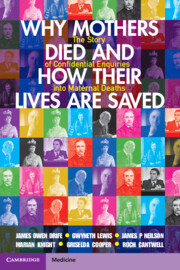 Why Mothers Died and How their Lives are Saved
Why Mothers Died and How their Lives are Saved Published online by Cambridge University Press: 05 April 2023
In 1952-4 the caesarean section rate was under 2% and many women died of complications of vaginal birth. The Report listed 190 deaths in an appendix under various causes including 'contracted pelvis', once common due to rickets. Pelvic measurement was part of antenatal care. In doubtful cases 'trial of labour' often ended in forceps delivery. A 10% fetal loss rate was considered acceptable. Home births could end in forceps delivery by GPs who had no postgraduate training and relied on their student experience. In the 1955-7 Report, 33 women died after forceps delivery at home or in a maternity home. In the 1960s 'prolonged labour' (> 24 hours) was blamed on 'inco-ordinate uterine action'. In 1969 in Dublin Kieran O’Driscoll introduced 'active management' for first-time mothers in hospital, showing that normal labour could safely be achieved with an intravenous oxytocin 'drip'. Early CEMD Reports criticised GPs but in the 1960s their comments became more constructive. The BMJ ran a series of articles, 'Obstetrics for GPs', written by leading obstetricians. By the late 1970s only 2% of births were home deliveries and the Reports no longer discussed place of birth.
To save this book to your Kindle, first ensure [email protected] is added to your Approved Personal Document E-mail List under your Personal Document Settings on the Manage Your Content and Devices page of your Amazon account. Then enter the ‘name’ part of your Kindle email address below. Find out more about saving to your Kindle.
Note you can select to save to either the @free.kindle.com or @kindle.com variations. ‘@free.kindle.com’ emails are free but can only be saved to your device when it is connected to wi-fi. ‘@kindle.com’ emails can be delivered even when you are not connected to wi-fi, but note that service fees apply.
Find out more about the Kindle Personal Document Service.
To save content items to your account, please confirm that you agree to abide by our usage policies. If this is the first time you use this feature, you will be asked to authorise Cambridge Core to connect with your account. Find out more about saving content to Dropbox.
To save content items to your account, please confirm that you agree to abide by our usage policies. If this is the first time you use this feature, you will be asked to authorise Cambridge Core to connect with your account. Find out more about saving content to Google Drive.